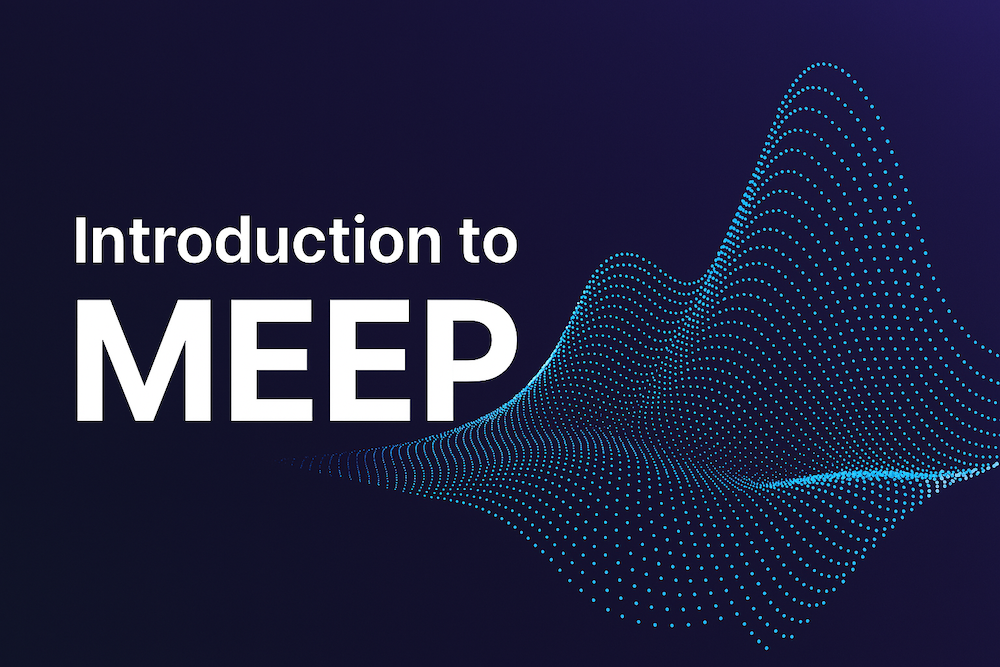Simulate Electromagnetic Waves with MEEP: A Hands-On Introduction
Modern technology—everything from smartphones to solar panels—relies on understanding how electromagnetic (EM) waves behave. But how do engineers test new optical devices or antenna structures before physically building them?
That’s where simulation tools like MEEP come in.

🔍 What is MEEP?
MEEP (MIT Electromagnetic Equation Propagation) is a free, open-source electromagnetic simulator that uses the finite-difference time-domain (FDTD) method to solve Maxwell’s equations.
In simple terms: MEEP lets you model how light, radio waves, or other EM waves interact with materials and structures.
Whether you're designing a photonic crystal, optimizing a waveguide, or experimenting with metamaterials—MEEP gives you a powerful, flexible way to simulate it.
🧪 Why Use MEEP?
- ✅ FDTD-Based: MEEP uses a time-domain solver, making it great for broadband simulations.
- 💻 Python and Scheme Interfaces: You can write your simulations using Python—perfect for engineers, researchers, and students.
- 📦 Built-in Material Models: Includes support for dielectric, metallic, dispersive, and nonlinear media.
- 🌐 2D and 3D Simulations: From micro-resonators to antenna arrays, MEEP can handle real-world complexity.
- 📊 Outputs in HDF5: Easy to visualize and analyze results using tools like Matplotlib, h5utils, or ParaView.
🚀 What Can You Simulate?
Some common MEEP applications include:
- Photonic crystals and bandgap structures
- Waveguides and resonators
- Nanophotonic devices
- Optical cloaking and metamaterials
- RF and microwave antenna design
- Solar cell light absorption optimization
🛠️ Installing MEEP (macOS example with Conda)
MEEP and its dependencies can be tricky to compile manually. Luckily, you can install it easily using Miniconda:
conda create -n meep_env python=3.9 -c chogan -c conda-forge pymeep gsl=2.6
conda activate meep_envThis creates a clean environment with all necessary libraries, including pymeep, libctl, gsl, and harminv.
🧠 Your First Simulation (in Python)
import meep as mp
cell = mp.Vector3(16, 8, 0)
geometry = [mp.Block(center=mp.Vector3(),
size=mp.Vector3(1, 8, 0),
material=mp.Medium(epsilon=12))]
sources = [mp.Source(mp.ContinuousSource(frequency=0.15),
component=mp.Ez,
center=mp.Vector3(-7, 0))]
sim = mp.Simulation(cell_size=cell,
boundary_layers=[mp.PML(1.0)],
geometry=geometry,
sources=sources,
resolution=10)
sim.run(until=200)This simple script simulates an EM wave interacting with a high-dielectric block in 2D.
📊 Visualizing Results
MEEP outputs data in .h5 (HDF5) format, which you can visualize using:
- Matplotlib (for field slices and animations)
- h5utils (
h5topng,h5totxt) - ParaView (for advanced 3D viewing)
📚 Resources to Learn More
- 📘 Official MEEP Documentation
- 📗 FDTD Method Book – Taflove & Hagness
- 🎓 MIT OpenCourseWare: Photonic Devices
🧭 Final Thoughts
MEEP is one of the most powerful open-source tools for simulating EM waves. Whether you're a student learning about Maxwell’s equations or a researcher designing cutting-edge optical devices, MEEP puts real-world simulation at your fingertips.
Get in Touch with us
Related Posts
- 面向中国企业的系统开发:以 AI + 工作流安全集成电商与 ERP
- Global-Ready System Development for EC–ERP Integration with AI & Workflow
- 不可靠的“智能”系统所隐藏的真实成本
- The Hidden Cost of ‘Smart’ Systems That Don’t Work Reliably
- GPU vs LPU vs TPU:如何选择合适的 AI 加速器
- GPU vs LPU vs TPU: Choosing the Right AI Accelerator
- 什么是 LPU?面向中国企业的实践性解析与应用场景
- What Is an LPU? A Practical Introduction and Real‑World Applications
- 面向软件工程师的网络安全术语对照表
- Cybersecurity Terms Explained for Software Developers
- 现代网络安全监控与事件响应系统设计 基于 Wazuh、SOAR 与威胁情报的可落地架构实践
- Building a Modern Cybersecurity Monitoring & Response System. A Practical Architecture Using Wazuh, SOAR, and Threat Intelligence
- AI 时代的经典编程思想
- Classic Programming Concepts in the Age of AI
- SimpliPOSFlex. 面向真实作业现场的 POS 系统(中国市场版)
- SimpliPOSFlex. The POS Designed for Businesses Where Reality Matters
- 经典编程思维 —— 向 Kernighan & Pike 学习
- Classic Programming Thinking: What We Still Learn from Kernighan & Pike
- 在开始写代码之前:我们一定会先问客户的 5 个问题
- Before Writing Code: The 5 Questions We Always Ask Our Clients














